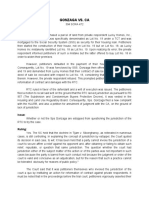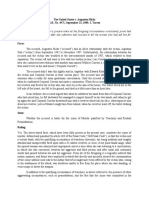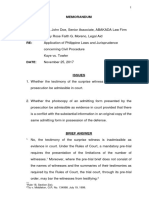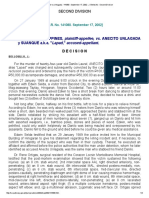People v. Arizobal
Uploaded by
Gain DeePeople v. Arizobal
Uploaded by
Gain DeeUNIVERSITY OF THE PHILIPPINES COLLEGE OF LAW Law 110 – Criminal Law 2
E2024 Professor Jimenez
People v. Arizobal
G.R. No. 135051-52 – December 14, 2000
En banc | Per curiam
Article/s Invoked:
Art. 295. Robbery with violence against or intimidation of persons; Penalties. — Any person guilty of robbery
with the use of violence against or intimidation of any person shall suffer:
1. The penalty of reclusion perpetua to death, when by reason or on occasion of the robbery, the crime
of homicide shall have been committed.
Case Summary:
Accused-appellants Erly Lignes and Clarito Arizobal (still at large) were convicted by the trial court of the
special complex crime of robbery with homicide and sentenced to suffer death penalty. Accused-appellant
tried to discredit the witnesses, but SC affirmed the conviction.
FACTS OF THE CASE
• March 24, 1994 – While asleep in their home, Laurencio Gimenez woke up his wife Clementina at
around 9:30PM to open the door because there were people outside. When she did, she was confronted
by 3 men armed with guns, two of whom she recognized as Arizobal and Lignes. While the third
unidentified man stood guard, the other two barged into the master’s bedroom and forced the aparador
open and obtained P8,000. Before leaving, they ordered Laurencio against his will to accompany them
to Jimmy Gimenez’s house. Shortly after they left, Clementina heard a volley of shots.
o In the home of Jimmy, after his wife Erlinda and her son had taken supper, Jimmy arrived with
a Francisco Gimenez. Husband informed his wife that they had bought a carabao and handed
her the certificate of large cattle. While he was skinning a chicken for supper, 3 men again
suddenly appeared and ordered them to lie face down. Francisco and Jimmy were tied up, with
the latter being whipped with an armalite rifle. The robbers ransacked the household, taking
P1,000 from her sari-sari store and told them to produce P100,000 in exchange for Jimmy’s
life. Erlinda offered them the certificate instead but they refused it. Another set of 3 masked
men dragged Jimmy outside the house together with Laurencio to some 50m away from the
house, with Arizobal and Lignes left to guard Francisco and Erlinda’s son. Moments later, there
was a burst of gunfire. Upon return to the house, the masked men told her that both her husband
and father-in-law had been killed for trying to escape.
• March 30, 1994 – Lignes was arrested and detained at the Cataingan Municipal Jail.
• August 12, 1994 – two Informations were filed before the RTC of Cataingan, Masbate, charging
Arizobal, Lignes, Gimeno and 2 John Does with Robbery in Band with Homicide for robbing and
slaying Laurencio and his son Jimmy. After arraignment, both cases were jointly tried.
• May 14, 1997 – Informations were dismissed against Gimeno were dismissed for lack of evidence
upon his motion. Only Lignes appear at the trial until its termination; Arizobal escaped from detention
and had to be tried in absentia. The 2 John Does were never apprehended.
o In his defense, Lignes testified that on that night he was attending the house blessing of a
neighbor in San Pedro, Cataingan, Masbate, the celebration of which ended at 1AM. He
presented a witness who confirmed his alibi, that around 9:30PM he was at the said house and
saw Lignes preparing food and drinks for the visitors. It would have taken 1-1/2 hours by foot
and 1 hour on horseback to travel to Tuybo from San Pedro.
• July 7, 1998 – trial court rejected the alibi of Lignes and found him and Arizobal guilty of robbery
with homicide, sentencing them to the death penalty and to indemnify the heirs of Laurencio P50,000
for his death and P20,000 for moral damages, and the legal heirs of Jimmy the same amount plus
P30,000 for exemplary damages.
• Cases went to the SC on automatic review in view of the imposed death penalty.
• Lignes, attempting to discredit the witnesses, pointed out that:
o Clementina said that she saw Lignes in the flea market 4 times, but on cross-examination
averred that she saw him only on 3 occasions;
UNIVERSITY OF THE PHILIPPINES COLLEGE OF LAW Law 110 – Criminal Law 2
E2024 Professor Jimenez
o She stated that 3 persons entered their house and recognized Arizobal and Lignes because they
lighted kerosene lamp, implying that neither were wearing a mask in utter disregard of the risk
of being identified;
o She failed to witness the actual killing when she said she only came to know of it on the
following morning after being informed by a neighbor, implying that Lignes was not positively
identified as the killer of the victims; and
o Erlinda stated that 3 robbers were not wearing masks while 2 were, but later contradicted
herself when she stated that 3 of the masked robbers executed Laurencio and Jimmy.
ISSUE/S & RATIO/S
1. W/N the prosecution witnesses are credible—YES.
• In the absence of any showing that the trial court’s calibration of factual issues, particularly on
credibility, is flawed, the Court is bound by it is assessment. The presumption is the trial court is in a
better position to decide the question.
o Lapses on the number of times Clementina saw the accused-appellant at the flea market, the
exact number of masked robbers and other minor details are not so serious to warrant the
reversal of the verdict, as both Lignes and Arizobal were categorically identified as perpetrators
of the crime.
• Failure of Clementina to actually witness the killing of her son and husband is of no significance
because there was conspiracy involved in the crime. Because it results in collective criminal liability,
it is not necessary to show that all the conspirators actually hit and killed the victim, only that all
participants performed specific acts with such coordination to indicate a common purpose in bringing
about the death of the victim. Lignes was sufficiently shown to have conspired in the commission of
the crime by his active participation in the acts of the group.
• Consequently, Lignes’ alibi crumbles in the face of positive identification by credible prosecution
witnesses. An alibi must be credible and tangible proof of physical impossibility for the accused to be
at the scene of the crime.
2. W/N the trial court erred in appreciating aggravating circumstances—For most; only dwelling was
correct.
• Dwelling is considered inherent in the crimes which can only be committed in the abode of the victim,
such as trespass to dwelling and robbery in an inhabited place. However, robbery with homicide can
be committed without transgressing into the victim’s domicile; here, the robbers demonstrated a
disregard of the inviolability of the victim’s abode.
• Treachery was incorrectly considered. Since this special complex crime is a crime against property,
not against persons, treachery cannot be validly appreciated as an aggravating circumstance. The
homicide here is merely an incident of robbery, with the latter being the main purpose and object of
the criminals. (This is a reversal of the ruling in People v. Bariquit)
• By a band cannot be aggravating, because there is no proof that at least 4 of the 5 perpetrators involved
in the commission of the robbery were armed. (Art. 296, RPC)
• Nighttime/nocturnity also did not attend in the commission of the crime. In this case, it was not
deliberately sought by the accused-appellants to help them realize their evil intentions. The place of
the crime (locus criminis) was well-lighted and nighttime was merely incidental to the whole situation.
RULING
RTC decision AFFIIRMED with modification. Lignes and Arizobal are ordered in addition: a) to pay jointly
and solidarily for the legal heirs of Laurencio and Jimmy Gimenez P50,000 for civil indemnity, another
P50,000 for moral damages, and P20,000 for exemplary damages, for each set of heirs; and b) to pay jointly
and solidarily the legal heirs of Laurencio P8,000 and those of Jimmy P1,000 representing their respective
actual damages.
You might also like
- Corpuz vs. People, 724 SCRA 1, G.R. No. 180016, April 29, 2014No ratings yetCorpuz vs. People, 724 SCRA 1, G.R. No. 180016, April 29, 201411 pages
- G.R. No. 224946 - Acharon vs. People en BANCNo ratings yetG.R. No. 224946 - Acharon vs. People en BANC55 pages
- Rivera v. Chua, G.R. 184458, Jan. 14, 2015No ratings yetRivera v. Chua, G.R. 184458, Jan. 14, 20152 pages
- People vs. Porras, G.R. No. 114263-64, March 29, 1996No ratings yetPeople vs. Porras, G.R. No. 114263-64, March 29, 19962 pages
- The United States v. Augustus Hicks G.R. No. 4971, September 23, 1909, J. Torres Doctrine of The CaseNo ratings yetThe United States v. Augustus Hicks G.R. No. 4971, September 23, 1909, J. Torres Doctrine of The Case2 pages
- People v. Magdueño, L-68699, 22 September 1986, 144 SCRA 210No ratings yetPeople v. Magdueño, L-68699, 22 September 1986, 144 SCRA 2106 pages
- 18 People Vs Unlagada - 141080 - September 17, 2002 - J PDFNo ratings yet18 People Vs Unlagada - 141080 - September 17, 2002 - J PDF4 pages
- Intestate Estate of Gonzales V People, GR 181409. Feb 11, 20100% (1)Intestate Estate of Gonzales V People, GR 181409. Feb 11, 201026 pages
- Cu Unjieng Sons, Inc. v. Board of Tax Appeals, 100 Phil. 1No ratings yetCu Unjieng Sons, Inc. v. Board of Tax Appeals, 100 Phil. 13 pages
- TANy35555555555555555eADAy VSy5 YyerULO DhearcasedigestNo ratings yetTANy35555555555555555eADAy VSy5 YyerULO Dhearcasedigest2 pages
- CRIM1 - People v. Escote (Aggravating-Treachery) G.R. No. 140756, 4 April 2003, 400 SCRA 603No ratings yetCRIM1 - People v. Escote (Aggravating-Treachery) G.R. No. 140756, 4 April 2003, 400 SCRA 6031 page
- People v. Robiños, G.R. No. 138453, 29 May 2002No ratings yetPeople v. Robiños, G.R. No. 138453, 29 May 200213 pages
- Taleon vs. Secretary of Public Works and Communication 20 SCRA 69No ratings yetTaleon vs. Secretary of Public Works and Communication 20 SCRA 6911 pages
- List of Cases For Constitutional Law 2 Ch. 14 - 22No ratings yetList of Cases For Constitutional Law 2 Ch. 14 - 227 pages
- People v. Arizobal G.R. Nos. 135051 - December 14, 2000No ratings yetPeople v. Arizobal G.R. Nos. 135051 - December 14, 20002 pages
- 90 Nielson & Company, Inc. v. Lepanto Consolidated Mining Company100% (1)90 Nielson & Company, Inc. v. Lepanto Consolidated Mining Company5 pages
- Cañedo v. Kampilan Securty and Detective Agency, IncNo ratings yetCañedo v. Kampilan Securty and Detective Agency, Inc3 pages
- Wing Kae Compradoring v. Bark "Monongahela"No ratings yetWing Kae Compradoring v. Bark "Monongahela"1 page

























































































